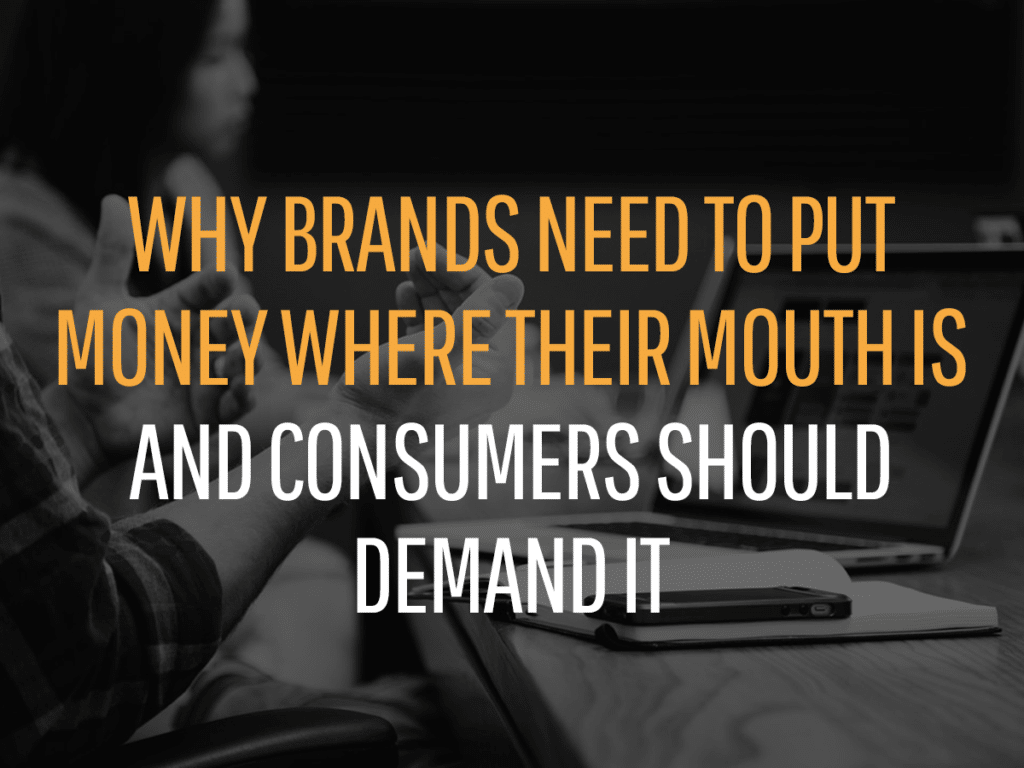Every day we hear more and more about the “informed” and “activist” consumer whose purchase decision making is not just influenced by traditional marketing practices, but instead by the attitudes, beliefs, politics, and social actions of the brands that they support. This can be seen with the loyal support of brands like Patagonia and their “Vote The Asshole Out” tags or the boycotting of brands like Hobby Lobby, Chick-fil-A, & Goya because of the personal and political beliefs of their owners. Many brands, in turn, have become increasingly focused on demonstrating their social positioning, responsibility, and conscience through formal statements of support, PR, social platforms, and financial gestures. We have seen this to an extreme in 2020 with a Presidential election and BLM, including the likes of Amazon, Apple, Coca-Cola, Facebook, Google, Home Depot, McDonald’s, Target, Nike, Walmart, Wendy’s, etc. making millions of dollars in donations to BLM and other supporting causes.
I will not say these gestures are disingenuous, insignificant, or unimportant, but what seems to get dramatically overlooked in this equation is where all of these corporations actually spend their BILLIONS of advertising and marketing dollars. Oftentimes we see these dollars, exponential in comparison to the public gestures, allocated to companies that have values or behaviors that contradict their stated social positioning. We do, on occasion, see brands alter their advertising spending behavior in support of a cause as we saw this summer with over 1,000 brands including the likes of CVS, Dunkin, Lego, etc. join the #StopHateForProfit and boycott Facebook.
I do not question the authenticity of these actions, but recognize the difference between temporary statements and long-term commitments. What I see more of, are brands continuing to support platforms that go against their stated positions. This is best demonstrated by the dozens of Fortune 100 brands that continued to advertise with the NFL when public support was overwhelmingly on the side of BLM. I have spoken with a broad variety of brand marketers about this, many of whom are official NFL sponsors, and their defense has been that the NFL is too valuable an audience for mass reach and, in turn, too powerful to go against…they actually fear being blacklisted by the NFL. How much would it have cost these brands to have teamed up and pulled their dollars until real change occurred?
We have in recent years seen a dramatic increase in brands focusing on “brand safety” and “brand suitability.” In 2020 this focus went on steroids. In addition to avoiding the obvious dangers like curse words and extreme violence, brands have become paranoid about consumers’ reactions to their ads running against content that might be contrary to their brand or consumers’ values. They are often even hiding where they are running campaigns. The most mind-blowing to me is how unaware these informed and activist consumers are of this contradiction and, at times, hypocrisy. As these consumers expect more transparency and authenticity from their brands and focus on the overt gestures, are they essentially getting duped? It is not hard to imagine customers’ reactions to the billions in advertising and marketing spent with companies that they would indeed find objectionable? With increased consumer scrutiny will we see a time in the near future where brands become exposed for not just running against objectionable content, but for the platforms, these brands are propping up? Is there a point where consumers will begin to demand an audit of where their chosen brands advertise? Will we see watchdog companies like “Charity Watch” come into play for consumers? Brand value scorecards? There are currently dozens of B2B companies focused on brand safety, but none yet available for consumer audits. I believe we are trending in a direction in which a marketplace for these services emerges.
So what are brand marketers to do? What, if any, moral responsibility or obligations do brands have; do brands truly need to have a conscience? How are these brand marketers who are measured not by brand values but by hard purchase, ROI, and profitability numbers expected to balance such moral responsibilities?
My hope is these advertising investments will come under greater scrutiny and consumer pressure will lead to investment decisions that manifest real change. If marketers had all stood up to the NFL, embodying the values their customers were demanding and supporting direct consumer pressure, then the league would have been forced to make real substantive changes versus the optics we have seen. Consumers ultimately hold the power and should demand to know where the brands they support are spending and what principles stand by. My advice to consumers…as Deep Throat said in All the President’s Men “follow the money!”




